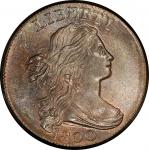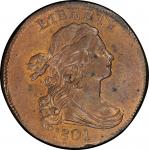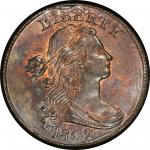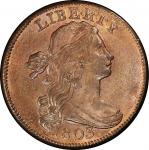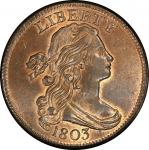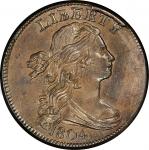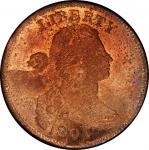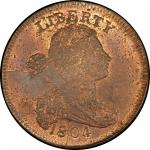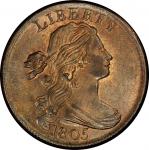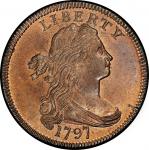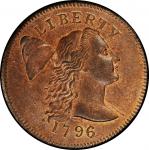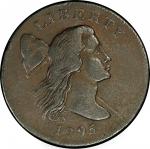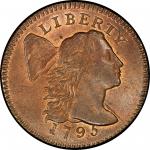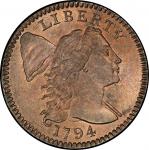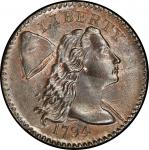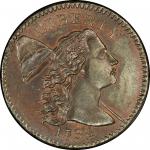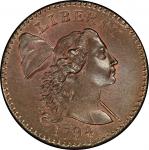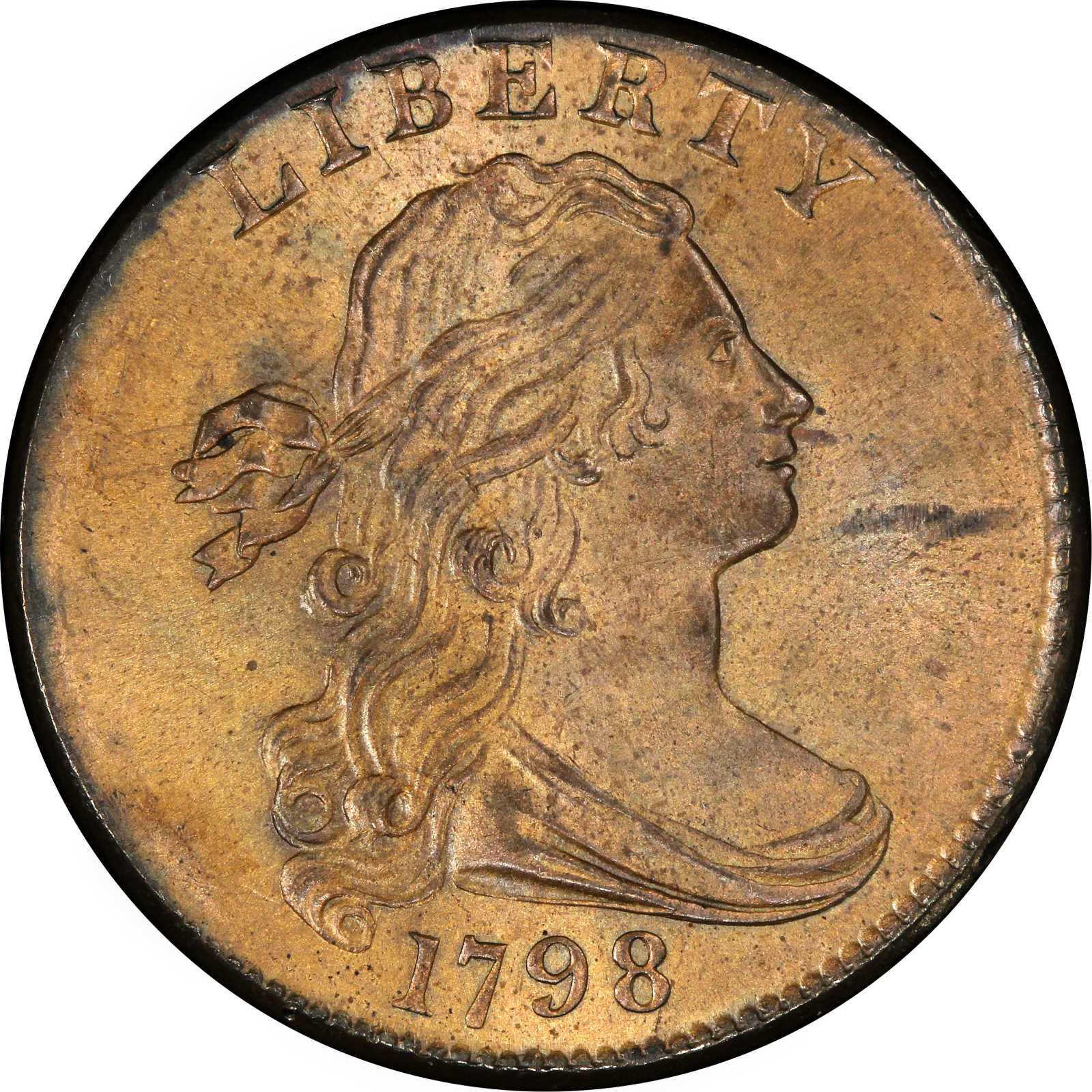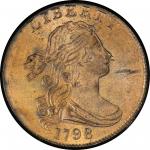Doug was known for creating colorful nicknames and phrases and many of these can be found on his typed coin envelopes ... Certain gem cents looked like a golden biscuit fresh from the oven. - Robert A. Schuman, eulogizing C. Douglas Smith, Penny-Wise, November 1999A triumph of frost and originality, the Garrett 1798 S-179 has been blessed with one of the highest honors in the realm of the early cents: a nickname bestowed by the late C. Douglas Smith. Smith, a collector and student of the cent series who formerly cataloged for this firm, was one of the driving forces of cent collecting from the 1940s through 1990s. A creative mind and an acerbic wit, Smith gave this coin the honorary title of "golden biscuit" to describe its superb and distinctive golden tan color. Ted Naftzger savored the name just as he delighted in this coins quality and unparalleled visual appeal.The surfaces of this coin are divinely lustrous, with incredible frost and unbroken cartwheel on both sides. The color has become fixed at one of the most desirable points on the continuum of copper oxidation, a process that pushes bright red through a range of tones before settling into a fixed shade ranging from lightest golden tan to deepest ebony brown. Barely fading from its original mint red, the obverse has assumed an ideal shade of golden tan, with darker olive framing the rims. Passing luster lifts up some shades that evoke the original mint color. The reverse shows both the golden biscuit shade and deeper olive, melodiously blended into a perfect satiny finish. A streak of darker color crosses the right obverse field horizontally, and some trivial and ancient spotting is noted amidst the letters of LIBERTY.The strike is precise and bold, nearly ideally centered and crisp from center to rim. A peak of denticles frames the right side of the obverse and perfectly frames the reverse. No heavy marks or post-striking flaws are seen. An extremely subtle batch of apparent hairlines in the upper right obverse field is less likely to be the product of an abrasion that affects the metal than to be the consequence of a disturbance or wipe in the "peach fuzz," the natural buildup that appears on a copper coin that has been left blessedly untouched for a century. It is precisely this buildup that makes this coin look so frosty and untouched and original. Untrammeled century-old buildup on a high grade copper is an incredibly rare phenomenon today.The die state appears early, the result of polishing to remove die clashes that befell this marriage in an earlier state. A shallow bulge appears on the coin behind Libertys lowest curls, the result of a sunken area in the die face. A faint streak of spalling is seen within the curls below Libertys ear, and tiny rim breaks hide in the denticles above the space between STATES and OF, the left side of F, and ME of AMERICA. Breen describes this state as his state IV.In the years following the United States Centennial, New York dealer Ed. Frossard positioned himself as a leading authority on large cents. Just a few years into his career as a professional numismatist, he helped build the remarkable collection of cents gathered by George Merritt, who abruptly stopped collecting coins altogether in 1878. Frossard sold Merritts cabinet in January 1879; soon thereafter, he doubled down on his own collection and the completion of a monograph on large cents that was largely illustrated with the Merritt coins. Frossard was still building his collection when he offered "A Fine Set of United States Cents" in his 25th sale, held on November 25, 1882. Many of the cents to be sold had passed through Frossards hands, however. Two of them, this one and a choice 1793 Wreath, had come from one of Frossards favorite sources, the Parisian collector Pierre-Édouard LeGras.Beneath the description of a medal struck in Paris to commemorate Le Gras, Frossard added a lengthy biographical note:Le Gras, or Pere le Gras, as he was familiarly called by his friends, is now dead, and the last part of his large cabinet will have been sold at auction in Paris at about the time this catalog makes its appearance. It was from Pere Le Gras cabinet that I obtained many of the rare early American coins offered by me within the last three years: A bright red Chain cent, 1793; a unique combination of the Wreath cent; the Liberty Cap cent, same year, now in the cabinet of Mr. Wm. H. Cottier; 1795 thick planchet cent, which sold for $85, and is now valued at $150; five uncirculated 1794 cents, now in my cabinet; many specimens of early dimes, half-dimes, uncirculated or proof; 1794, 1795 (Bushnell sale), 1801 and 1802 half dollars, uncirculated, etc., et.c A few among the fine cents offered in the following lines also originally came from his cabinet, but are not my property at the present time. To judge from his American coins, Pere le Gras must indeed have been a collector of taste and the possessor of a splendid cabinet.In the biographical paragraph above, the "bright red Chain cent" may be familiar as the Pogue Sheldon-3, which spent nearly a century alongside this coin in the trays of the Garrett Collection. The unique Wreath cent Frossard got from Le Gras is now known as 1793 NC-5; it remains unique today. And the 1793 Liberty Cap that Frossard sold to William H. Cottier is more associated today with the Eliasberg Collection; it is considered the finest known surviving specimen.Described as "1798 Small date. Brilliant olive obverse; fine impression and perfectly uncirculated. From the Le Gras cabinet," this cent brought $10.25. It would not be offered again for nearly a century. In 1979, it was bid from an open of $2,300 to a final hammer price of $18,000, selling to Ted Naftzgers friend and agent Stanley Kesselman, after Naftzger agreed to lay off the lot as a favor to C. Douglas Smith, who coveted the coin as an upgrade to his EF-45 specimen. Naftzger didnt give up his pursuit of the Golden Biscuit, and successfully swapped what he called "an AU cleaned Chain ¢" for it over a year after the sale. It remained in the Naftzger Collection until acquired by D. Brent Pogue in 2008. When first seen at lot viewing for that sale, your catalogers eight-word notation next to this coins description included the word "awesome," a mention of the coins "light faded color," and a forceful but complimentary obscenity.This coin has been consistently ranked by Noyes as tied for finest known of the variety, always tied with two others. One of those is the Beckwith-Newcomb-Sheldon coin that sold as part of the Thomas Reynolds Collection in January 2016 as PCGS MS-65 BN; it is perhaps instructive that Naftzger sold that one in 1992 but kept this one until his death in 2007. Aside from this coin and the Beckwith-Newcomb-Sheldon-Reynolds coin, Noyes has listed two different coins in the third "tied for finest known" position. In 1991, it was the Doug Smith-Fred Borcherdt coin; Bland singled that specimen out as finest known in 2000. In Noyes 2005 census, that coin was listed alone as fourth finest known, while the specimen sold as lot 8 in the 1989 ANA sale was elevated into a tie as finest known; the latter specimen is graded just AU-55 by Bland and is ranked in fifth position.Condition Census rankings will inevitably cause disagreements. Tastes vary from person to person and, as seen above, even a single persons taste can change over time. In contrast to the malleability of aesthetics, this coin has remained a stunning gem for centuries, no different today than it was when Frossard adjudged it "perfectly uncirculated" in 1882. It is the single finest 1798 cent ever certified by PCGS, the only example of the date ever graded higher than MS-65.




